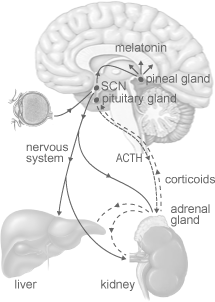 circadian rhythms
circadian rhythms
Circadian rhythms regulate physical, mental and behavioural variations occurring over a roughly 24-hour cycle, responding primarily to light and darkness in an organism’s environment. They are found in most living organisms, including animals, plants and many tiny microbes.
In human beings and other mammals, the suprachiasmatic nucleus (SCN) located in the hypothalamus functions as the master pacemaker of an endogenous circadian timekeeping system. The SCN receives photic input from the retina via direct and indirect pathways, thus forming the prime relay between external and internal times.
A network of circadian clocks is synchronised with external time via humoral and neuronal pathways. From the SCN peripheral clocks throughout the brain and the body are synchronised via the autonomic nervous system. Rhythmically released hormones like ACTH from the pituitary, melatonin from the pineal and corticoids from the adrenal also contribute to the synchronisation of physiological functions and provide feedback to the SCN.